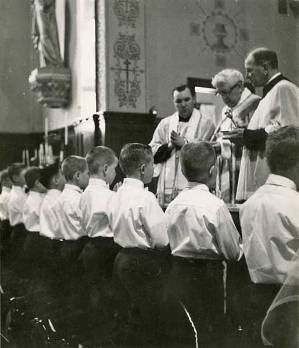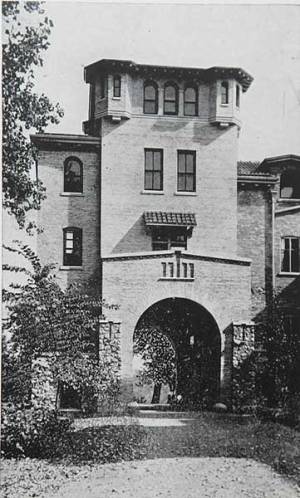Shared Secrets Reveal Much Suffering
in Silence
As Boys, They Felt Trapped by a Beloved Priest's Abuse at St.
John's School for the Deaf. As Men, They Learn They Weren't Alone
By Mary Zahn
Milwaukee Journal Sentinel
March 26, 2006
http://www.jsonline.com/story/index.aspx?id=410863
First of two parts
[See also the other articles in this feature: Shared Secrets Reveal Much Suffering in Silence, by Mary Zahn, Milwaukee Journal Sentinel (3/26/06); Staring Abuse Straight in the Face, by Mary Zahn, Milwaukee Journal Sentinel (3/27/06); Range of Settlements for Victims Questioned, by Mary Zahn, Milwaukee Journal Sentinel (3/26/06); Editorial: A Window for Accountability, Milwaukee Journal Sentinel (3/27/06); and a Gallery of Photographs with notes on this feature.]
Thirteen-year-old Arthur Budzinski hid under his bed crying. Born to
hearing parents who did not speak sign language, he could not tell them
of the terror he faced back at St. John's School for the Deaf in St. Francis.
It was 1962. When the truth was told decades later, they all would weep.
 |
| Giving voice to his anguish, Arthur Budzinski, 57, uses American Sign Language to tell of his abuse decades ago by Father Lawrence Murphy at St. John's School for the Deaf in St. Francis. Although Murphy died in 1998, his abuse continues to haunt Budzinski and other men who have come forward with similar stories. Photo/Kristyna Wentz-Graff |
Arthur's story and those of dozens of other adolescent deaf boys who
attended the Roman Catholic boarding school hides in the shadows of a
snapshot of the school's basketball team:
Eleven boys are dressed in their uniforms, half kneel and half stand.
Next to them in a long, black clerical gown holding a basketball is Father
Lawrence Murphy, the long-revered, charismatic director of the school.
Of the 11, five of them would be molested by Murphy.
Sometimes it was during confession, and often it was in the dead of night.
 |
| Of the 11 boys on St. John's basketball team (in this 1960s photo), at least five say they were victims of sexual abuse by Father Murphy (left). Photo/Contributed |
Murphy's victims are now middle-aged and are coming forward to ask the Archdiocese of Milwaukee to compensate them for their suffering. The Journal Sentinel recently interviewed eight of them. It took them weeks to decide whether to tell their stories. Their continuing fear, shame and anger are testament to the power Murphy still wields over some of them, eight years after his death.
"Many say 'Oh, forget it, it's in the past,' some are upset, some don't care and some are still very angry but are afraid to come forward," said Budzinski, 57, who lives in West Allis. "The whole situation has torn the deaf community apart and continues to divide them.
"We want to hold the church accountable and force the church to acknowledge that this was not just a handful of children who were abused."
 |
| Arthur Budzinski watches translator Mala Boyce sign into a TV camera during a video conference at his West Allis home with his friend Robert Bolger, who lives in California. Bolger and Budzinski say they were abused by Father Lawrence Murphy at St. John's School for the Deaf in St. Francis. Photo above, Rick Wood. Photo below, contributed. |
 |
He never apologized.
The stories of the survivors also give a rare glimpse into the isolation of Milwaukee's deaf community from 1950 into the 1970s. Devices that enable deaf people to use the telephone were not widely available; closed captioning of television programs had not begun; and many people who hear considered deaf people to be mentally retarded.
Murphy, who was fluent in sign language, became a key link to the hearing world for the many deaf children who, like Budzinski, were unable to talk with their hearing parents.
"Back then there was no way to communicate," said his mother, Irene Budzinski, 89. "I never learned sign language. When you had a deaf child, the public health nurse would say, 'Send them to some school.' We were looking for a good place.
"Who would think any harm would come to a young child?"
 |
| At their first Communion, students at St. John's School for the Deaf received a rosary and catechism as gifts from Murphy. Steve Geier, 55, of Madison, who holds the gifts, came to St. John's at age 8. Photo/Contributed |
"Here is my mom and dad, talk, talk, talk, talk, and I am looking at them," he said. "My suitcase gets put down, and my mom and dad said we have to go home. So I go running after them. They said 'No, you stay here.' It was confusing and I cried."
Murphy would console him.
The Milwaukee Archdiocese has acknowledged that Murphy abused boys at the school, which was at 3680 S. Kinnickinnic Ave. in St. Francis, but has provided few details. The residential school closed in 1983 for financial reasons.
The archdiocese denied requests for church records regarding Murphy's offenses, citing victim confidentiality.
"We firmly believe that these individuals have suffered so desperately in their lives that it is far more appropriate to listen to them - hear their stories of pain, grief and suffering - than it is to dig through our records for arcane facts and data, which we believe must be held in confidence," Kathleen Hohl, communications director for the Archdiocese of Milwaukee, wrote in her response to the newspaper.
Two of Murphy's victims recently received $100,000 and $200,000 in compensation through an archdiocese-sponsored mediation program for sexual abuse victims. As part of that agreement, they had to agree not to sue the church.
Pending state legislation would allow victims of clergy sexual abuse to bring civil suits against religious organizations within a one-year window, regardless of when the abuse occurred and past statutes of limitation. In a civil court, a plaintiff could compel the religious organization to produce any documents it might have relating to the case, regardless of whether the accused clergy member is able to participate in the organization's defense.
"I still have nightmares," said Gary Smith, who lives near San Antonio.
A pillar of deaf culture
Few reminders are left that St. John's School for the Deaf was once the lifeblood and pride of Milwaukee's close-knit deaf community.
A worn concrete pillar with a faded angel holding a scroll remains at the beginning of the circular drive to the brick and concrete buildings, now a St. Francis elementary school and recreational facility. In the gymnasium where the St. John's boys basketball team won many victories as cheerleaders roused the crowd, a round green marker in the middle of the floor still boasts "St. John's."
 |
| St. John's School (the dormitory is shown) opened in the 1800s and closed in 1983 because of financial reasons. Photo/Contributed |
Students, parents and friends of the deaf community toiled over picnics,
candy sales and athletic events for years to scrape together enough money
for these buildings. They were erected in the mid-1960s to replace the
crumbling originals that were built in the late 1800s, when the school
was known as St. John's Institute for Deaf Mutes. Enrollment ranged from
82 students in 1949 to a high of 161 in 1968.
At the center of the building frenzy was Murphy, a gregarious Irishman,
short in stature with a smile that could melt ice. Yearbook photos and
newspaper clippings show him as a whirlwind of activity, accepting thousands
of dollars for the school from civic groups, coaching basketball and giving
speeches all over town about deafness and why people should contribute
to St. John's.
But it was Murphy's ability to speak American Sign Language so gracefully
and beautifully that sealed his closeness to the deaf community. Parents
and students loved to see him sign the Sunday Mass, which was described
by some as truly spiritual.
When Murphy arrived at the school in 1950, newly ordained, Sister Mary
Claude Telderer had worked there for seven years.
"He was very beloved," Telderer, 83, said. "The children
just loved him. For his birthday every kid got a bag of treats, and we
had a movie, and that was big stuff. He would come around to the classrooms.
He would come in, and he would make you feel like a million dollars.
"Never in my wildest imagination did I think the children were in
danger."
Murphy's well-connected friends contributed basketballs and baseballs
and supported his push to replace the old, castle-like buildings. He established
an athletic program and an alumni association.
"He has taught us about faith, love, service and loyalty," the
seniors wrote in the 1971 yearbook, which was dedicated to Murphy.
By all accounts, Murphy was enthusiastic and patient with the children.
"He was a wonderful teacher," said Gary Smith, echoing what
the other victims said. "We loved him."
'God, what's right?'
The men's stories are similar. Murphy would call them to his bedroom in
the school, or visit them in their dorm beds late at night, masturbate
them and leave. Sometimes he would go on to other boys. Often he would
say nothing. Sometimes when the boys saw him molesting other boys in the
dorm room, they would cover their heads with their blankets, hug themselves
tightly and weep. At times, he would take their confession in a second
floor walk-in closet in the boy's dorm and molest them.
"Murphy was so powerful and it was so hard," said Geier who
was molested when he was in seventh grade and said he saw more than a
dozen other boys molested. "You couldn't get out. It was like a prison.
I felt so confused. Here I had Father Murphy touching me. I would be like,
'God, what's right?' "
Geier said the boys received no sex education and had no idea what was
happening to them. Some, he said, believed it must be all right because
it was being done by a priest. After he resisted one of Murphy's advances,
Geier said, Murphy refused to allow him to go with a group of boys to
get ice cream across the street.
During one interview, Budzinski began to get tears in his eyes as he recounted
seeing Pat Cave being molested in his dorm room bed. Cave, 57, who lives
in Seattle, said he thought he was the only one molested until 2004, when
he shared his experience with Budzinski.
Cave added that his older brother, who also attended St. John's, often
would be called to Murphy's office at night and be gone for long periods.
They never discussed why. His brother died in a motorcycle accident at
age 21.
'I never told anyone'
For James Smith, 62, of Orange City, Fla., the memories are intense. He
began to shake and cry as he recalled one incident after another.
"I would be playing baseball, and the boys would come and say, 'Father
Murphy wants you to come and see him,' " Smith said. "I would
refuse to go, and pretty soon I was dragged into his office and molested
again.
"I never told anyone. I thought I was alone."
Like other victims, Joe Daniels, 58, of Union Grove was not believed when
he tried to quietly tell family members and other adults about the molestations
when he was in his 20s.
"It was an awful thing," Daniels said. "I felt anger and
shame."
"Some of them are still really, really afraid," said Cohen-Stein,
the therapist who has worked with victims of Murphy. "They feel their
entire life revolves around this lie - their identity, their feelings
toward hearing people and about themselves.
"One person actually said: 'I would have to rebuild myself if I started
talking about this. I would fall apart because all of the threads are
so tangled.'"
Any original material on these pages is copyright © BishopAccountability.org 2004. Reproduce freely with attribution.